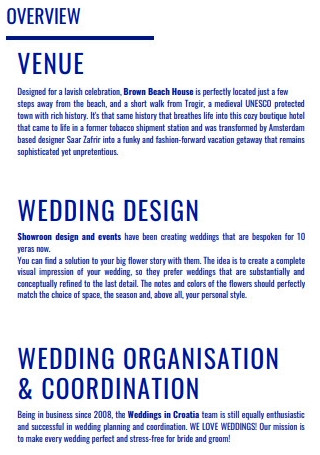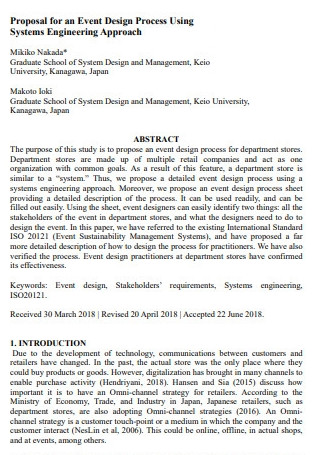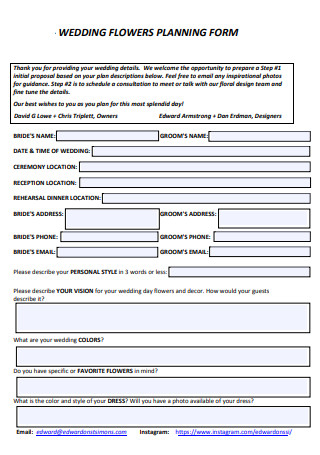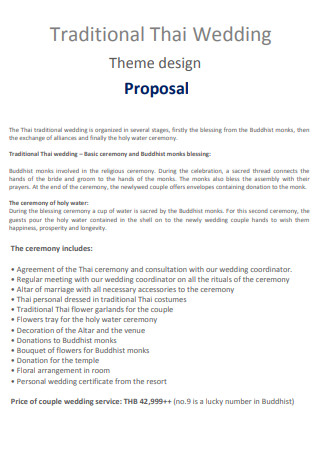5+ SAMPLE Wedding Design Proposal
FREE Wedding Design Proposal s to Download
5+ SAMPLE Wedding Design Proposal
What Is a Wedding Design Proposal?
Elements of Designing the Wedding
Additional Tips for Designing the Wedding
How to Write a Wedding Design Proposal
FAQs
What is the difference between wedding designers and planners?
How much does the wedding design company charge?
What should your budget be when planning a wedding?
What Is a Wedding Design Proposal?
Merriam-Webster Dictionary defines design as a rough sketch or outline of something to be executed that shows the essential characteristics. It can comprise a wide range of practical arts, such as fashion, interior design, and graphic design. The graphic of the participants, the equipment used during the ceremony, and the organization of the place are all examples of wedding design. Searching through various mood boards and samples of invitations design may give you wedding proposal design ideas. But it could also contribute to you losing the moment’s uniqueness. Remember to pursue originality and eccentricity by still coming up with original ideas.
Elements of Designing the Wedding
Couples choose wedding venues for a variety of reasons, and the venue that best meets their needs may or may not reflect their wedding style. Regardless of design or décor problems, a vegan kitchen, an especially big guest capacity, or even the sentimental value of a certain location may make it a must-have. Fortunately, there are a variety of solutions for temporarily yet entirely transforming a wedding venue, and with the right team behind you, the sky truly is the limit. Go through this curated list of the necessary elements that will help out in designing the client’s wedding.
Additional Tips for Designing the Wedding
Before you proceed to write the wedding design proposal, here are some additional tips to help you in designing your client’s wedding. If you have been in the wedding planning industry for a while now, then you are more than aware of the importance of the items found in the list. But any good expert deserves to be reminded of the following.
How to Write a Wedding Design Proposal
Now that you have reached this step, it is finally time to write the wedding proposal design so you can bring the document to your clients and review whether or not the contents of the said proposal are up to their standards. If you are more of a visually professional and would want references to base your proposal on, then you can proceed to the available wedding planning proposal example that this site has prepared. Alternatively, there are templates as well that you can use and edit as much as you wish.
Step 1: Create a Cover Page
As the first thing that will be seen and met by your clients, you will need to pour an extra amount of effort into crafting the cover page. You will need to make it captivating but also pleasant, not in the sense that you will be overdoing the layout but enough to capture the attention and your overall statement of the proposal. The pages following the cover page will then give an overview of the contents.
Step 2: Specify the Chosen Venue
The next section will have you talking about the location of where the ceremony and reception will take place. Depending on how large the event is, oftentimes the ceremony will be held within a church or another location and then the reception will occur in a restaurant, an event hall, or another area. This is why in your proposal, you will talk about each of the venues in a way that clients will be aware of where you are going with your proposed design.
Step 3: Bring up the Initial Inspiration and Theme
Take out those palettes, sketches, and suggested cake designs because this step will act as a preliminary of your thoughts as a wedding planner and designer. This step is where you will bring up what you and the client have initially discussed. It is a mix of a run-through of the shared ideas as well as making sure both parties have understood one another. This will lead to the next step.
Step 4: Discuss the Proposed Design
The fourth step will require you to finally discuss your proposed design. After deliberating with the clients and discussing the colors, theme, and motif of the event, it is time to show them what you have in mind for the design. This is more concrete than the earlier step because you may need to show further photos and physical elements to show to them. Some additional things you will be showing are the table design and the seating arrangement.
Step 5: Elaborate More on the Stationary and Giveaways
Although not as important in the grand scheme of things, this part is still considerably included in the design because of how it can impact other parts of the wedding event. This means that the client will need to settle on a specific font and color for the invitations that would go well with the overall design of the event as well as the giveaways that will also play a part in tying the event and the guest.
Step 6: State Your Terms and Conditions
The final step is where you are stating your side of the arrangement. Even as a wedding planner and designer, the client can’t expect you to perform or go through a service you are not comfortable or capable of doing. This is why you need to clarify what your services entail and how much you are charging them for employing you. Don’t be pressured to lower your prices because your effort is already a tedious process.
FAQs
What is the difference between wedding designers and planners?
From vendor recommendations and contract negotiations to the day-of implementation of your vision, wedding planners are all about the details. Some wedding planners also offer design or style services, assisting you with the creative components of your big day, while others prefer to leave those to a wedding designer. A wedding designer’s duty is strictly aesthetic, and it does not entail contract discussions or accompanying the bride to appointments. Their responsibilities include developing the wedding’s design idea, advising on color palettes, managing the décor budget and vendors such as the florist, rentals, lighting, stationery, etc.
How much does the wedding design company charge?
Wedding planners vary their costs with regard to the state or city they are in and depending on the company’s skill and popularity. All of this is dependent on the wedding budget or scale, as well as the destination or venue that is chosen. Since some weddings can be small and simple, wedding design companies must allocate a price point that fits into the arrangements of specific events. This also goes for a wedding that is much larger in scale with more guests to accommodate. Think of that carefully the next time you draft a wedding event planning proposal.
What should your budget be when planning a wedding?
No two event is ever the same, as a wedding planner and designer, you will be more than aware that in your line of work, each client is unique in requesting specific elements over the other. So based on that, a usual wedding project proposal budget would prioritize the venue hiring cost, the catering, and the wedding planner itself which would also depend on the level of services the clients are hiring you for. Then what would follow is the wedding ceremony, the wedding rings, the outfits, the photographer or videographer, and lastly the wedding cake.
Coming up with a marriage proposal design will take you quite a while. Not only would the brainstorming phase occupy most of your time, but you will also need to perform physical searches for the right decoration that would go well with the venue and the vision of the couple. This is why making use of a template that this article has readily provided for you will help you save time.






